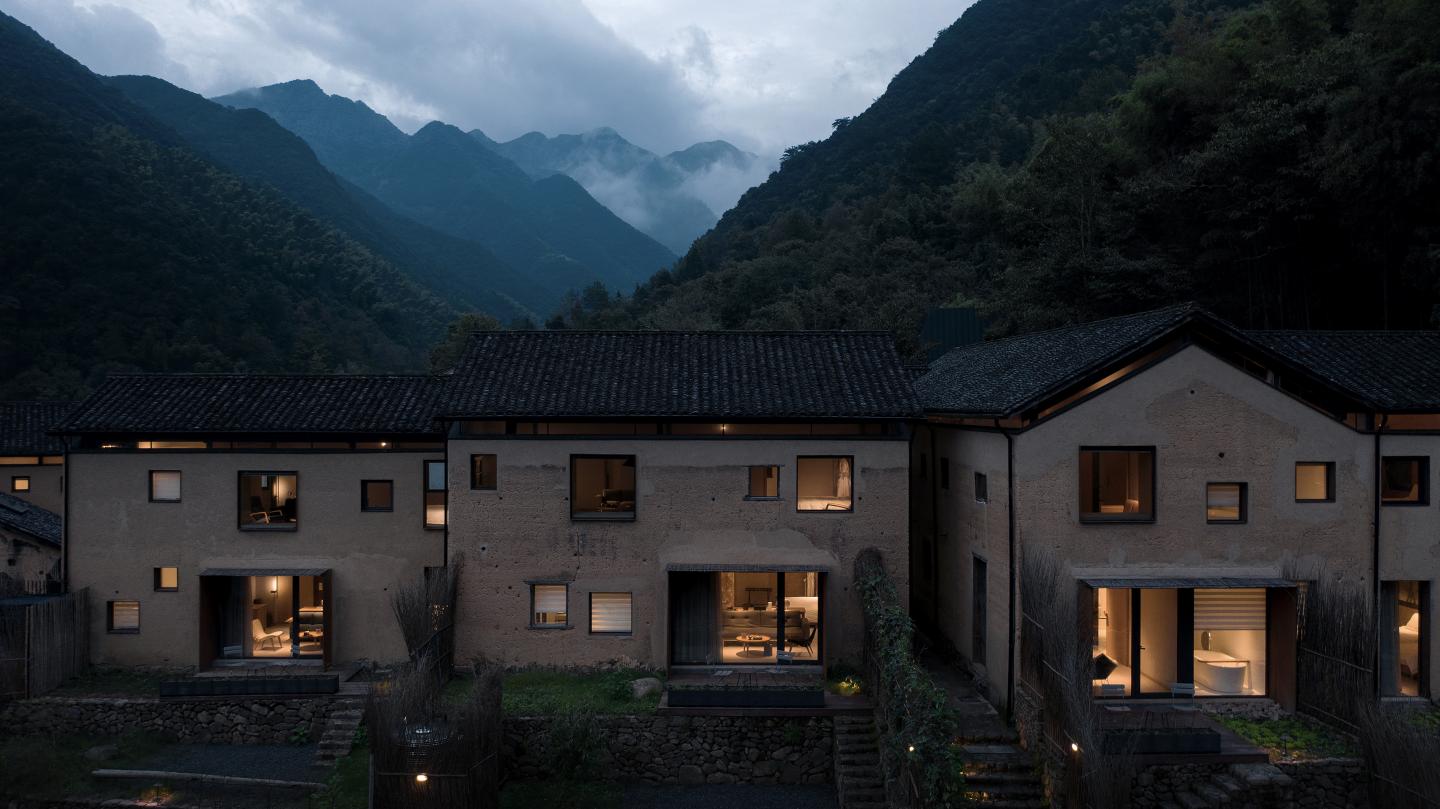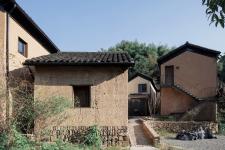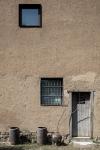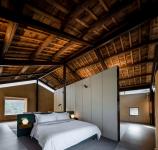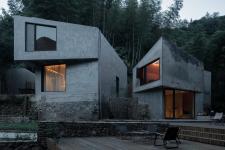Flowing Cloud Township Villa is located in Qinglongwu,a centennial village in Tonglu. In 2017, MDO was commissioned to renovate 6 existing village houses and transform them into guest houses, a reception, bar and restaurant.
MDO’s idea was to create a new rural retreat which celebrates local culture and tradition through the sensitive renovation of the old structures, using local techniques, local materials and local craftsmen. Visitors will be able to experience an environment in touch with the nature, a chance to disconnect from their busy urban lives. The retreat will offer new employment opportunities for local people, allowing them to share their rich cultural heritage.
Time and patina
When we first visited the site we were interested in the existing buildings and their relationship with the landscape. The buildings are all sited in a valley very close to each other linked by a small cobbled street. Each buildings looks out onto Bamboo forest which envelopes the village.
The buildings have this great sense of ageing, the old walls and windows tell the stories of the past through the marks and imperfections on their surfaces.
The existing building had a traditional timber. We wanted to see if it was possible to keep it and adapt it. However on closer inspection we realized the existing structure and roof were too weak and damaged to be retained. The existing windows were very small which created a dark a gloomy internal environment with no real visual connection to the beautiful bamboo forest.
Sensitive renovation
The design approach is to modernise the existing buildings with a sensitive approach and improve the relationship with the landscape. The existing structures of rammed earth walls, historical windows and doors are all retained and refurbished. New elements are treated as modern insertions allowing guests to clearly read the relationship between the old and the new.
We added underfloor heating and modern bathrooms to make the space feel very comfortable, but the other functions were kept quite simple to be less of a distraction. So the guests can avoid TV or other digital distractions and focus on real interaction with the nature or their friends and family.
Social connection is at the heart of the project. The design creates moments for people to come together to enjoy each other’s time. Whether it be an external space for group bbq, or living area for families to chat, to more private quiet spaces for people to have some time for self reflection, in each environment the design focuses on the connection between the landscape and existing buildings.
Sunlight
Away from the hustle and bustle of the city, we hope that our guests can experience the changing rhythm of the four seasons.
The dilapidated roofs were lifted and restored with traditional techniques and materials to create more usually ceiling heights. A clerestory window was formed around the edge, allowing diffused light to penetrate the depths of the space, and guests can see the bamboo forest from any angle in the room.
To improve the internal daylight we introduced new windows which followed the random timber window of the old building. These new additions were finished in a thin metal frame, distinguishing them from the existing.
The placement of these new windows was very important, as we wanted to frame the landscape from certain positions inside, for example the view from the bed, or the view from the sofa, or the glimpse of the valley from the shower, the landscape is treated almost like a painting.
Place and environment
Two new buildings were created on the foundations of a collapsed structure and establish a new dialogue with the countryside and nature.
The surface of the new buildings are rough concrete, in contrast to the traditional rammed earth of other village buildings. The concrete is allowed to weather, so that overtime they will be integrated into the landscape blurring the boundary between architecture and nature. The rough facade contrasts with the crisp windows which frame the softer, warmer interiors.
The creation of the framed window scenery makes the bamboo forest an indispensable part of the interior. During the day, the passing of daylight is reflected on the wall as the shadow changes. When night falls, guests can watch the twinkling starry sky through the windows, enriching the memories of travellers here.
“The moon is hazy and the lights are noisy, and the stars are shining in the Lanxuan.”
The traditional lantern culture has been transformed into the inspiration and starting point of the lighting design. We regard the new building as a beacon that guides travelers. No matter what direction people approach it from, it welcomes people to enter it.
The changing light colors suggest the change of space function, and it is also a direct indication of the dynamics that are taking place in the space and the atmosphere of the space.
The architecture and space of Flowing Cloud Village are technical products of local crafts and culture. The vast China has a diverse culture, landscape and people, so there will never be a solution that can be applied to all environments. As designers, in the future, we will devote ourselves to studying and understanding the nuances and creating a unique design for each place.
2017
2021
Category:Village Renovation
GFA:1300㎡
Main structure:Rammed earth, Reinforced concrete
Functions:Guest houses, reception, bar and restaurant.
Materials:Wood, Concrete, Glass, Steel structure system, Rammed earth
Design Firm:MDO (MORE DESIGN OFFICE)
Design Director:Justin Bridgland, Jaycee Chui
Design Team:Da Gao, Szuniang Tseng, Carlo Alberto Follo, Yabin Yao, Kelsey Alexander, Yanping Tang, Shengnan Xia, Haiyan Peng, Zhiyuan Wang, Jiacheng Que, Di Chang
Photographer:Zhi Xia, Xun Zheng, Zhao A, Andy He
Favorited 2 times
